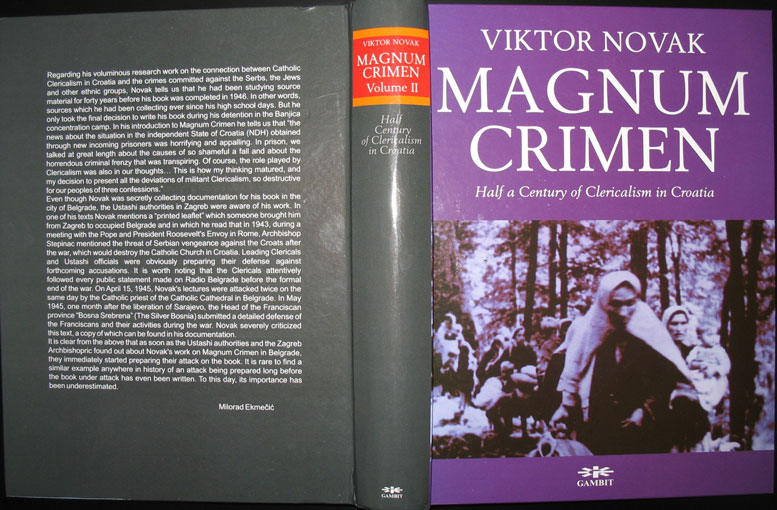
Views: 2569
Magnum Crimen the book about clericalism in Croatia from the end of 19th century until the end of the Second World War.
The book, whose full title is Magnum crimen – pola vijeka klerikalizma u Hrvatskoj (The Great Crime – a half-century of clericalism in Croatia), was written by a former Catholic priest and professor and historian at Belgrade University, Viktor Novak (1889–1977). The book was first published in Zagreb in 1948.
Immediately after the book was published, the Vatican Curia placed this book on the Index Librorum Prohibitorum (English: List of Prohibited Books) and pronounced anathema against the author.
Background
Novak wrote a trilogy, of which the last part was Magnum crimen (the first two parts were the Magnum tempus and the Magnum sacerdos). A Croat by birth, he has been, since 1924, active among the Serbs. He has held the Chair of Croat History, which was founded at the University of Belgrade in order to promote mutual understanding between the two kindred peoples. One of the determining factors in his life was his visit to Rome before 1914 and his research in the Vatican Archives. As a medievalist he came into a close contact with problems of modern religious life and took lively interest in relations between the Vatican and Catholic Croats.
Observing the Roman Catholic Church activities in Yugoslavia for more than fifty years, Novak concluded that this Church replaced the idea of service to God with service to the Roman Curia, i.e., to the government of Roman Pontificate in the role of world leader. As a result of this idea, in the Kingdom of Yugoslavia, the Roman Catholic Church identified the Roman Catholicism to the Croatian nationhood which turned most of its priesthood into ardent Ustashe supporters.
Content
The book describes the activities of the Roman Catholic clergy in the Kingdom of Yugoslavia, including their intention and attempts to become above the state, to control the state and eventually the everyday lives of the common people. It has two distinct parts. The first part consists of fifteen chapters, covering the Roman Catholic clericalism from the end of the nineteenth and beginning of the 20th century in Austria-Hungary, then in the Kingdom of Yugoslavia. The second part, the last four chapters, covers the rise and fall of the Independent State of Croatia, and the active support of the Roman Catholic clergy.
The main doctrine of the Roman Catholic Church in the Kingdom of Yugoslavia was that (a) the clergy shall be paid by the state as state officials; (b) the state cannot have any control over the Church; (c) the Church has right to be fully involved in the political life of the Kingdom of Yugoslavia; (d) the Church doctrine/religious education shall be a part of primary and secondary school curricula; and that (e) the Roman Catholic Church curricula in the schools shall be obligatory to all pupils whose at least one parent is a Roman Catholic.
Josip Juraj Strossmayer’s ideas, of which the most important one was that serving God is equal to serving the people, created close relations between Croats and Serbs by introducing the Old Slavonic language as the liturgical language of the Roman Catholic Church in the Balkans and were aggressively suppressed by the Roman Catholic clergy in Croatia and Slovenia.
Ante Pavelić’s nationalism identified Roman Catholicism with the Croat nation, which was actively supported and interpreted by the clergy.
The second part of this book focuses on the establishment of the Independent State of Croatia, the active support of this state by the Roman Catholic clergy, and their involvement and support in the extermination and/or forceful conversion of the Serbs and extermination of the Jews and the Roma people.
Archbishop Aloysius Stepinac is portrayed in this book as an ardent Roman Catholic crusader who publicly endorsed the establishment of the Independent State of Croatia, acknowledged the Ustashe as Croatian patriots, defended it before the Roman Pope and was responsible for the racist attitude and behavior of his clergy.
Source: www.magnumcrimen.org
Origins of images: Facebook, Twitter, Wikimedia, Wikipedia, Flickr, Google, Imageinjection & Pinterest.
Read our Disclaimer/Legal Statement!
Donate to Support Us
We would like to ask you to consider a small donation to help our team keep working. We accept no advertising and rely only on you, our readers, to keep us digging the truth on history, global politics and international relations.
[wpedon id=”4696″ align=”left”]
FOLLOW US ON OUR SOCIAL PLATFORMS










